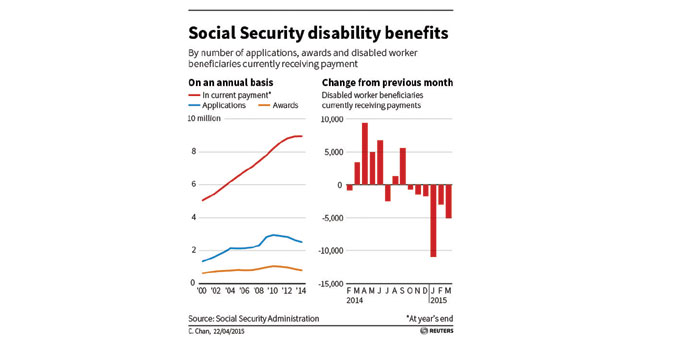Reuters
Washington
The number of Americans on disability has declined for six months in a row in a sharp turnaround after years of increases, more evidence of the labour market recovery the Federal Reserve wants to see before nudging interest rates higher.
Social Security disability rolls have climbed since the 1980s as the US population has grown older and soared during and after the global financial crisis. That stoked fears that shrinking workforce will stunt the economy’s future growth.
The surge also raised the prospect that the program could run out of money and triggered calls for tougher eligibility rules as part of a broader political stand-off over the scope and costs of Social Security.
The trend reversal may help dispel funding fears and take the edge off the political confrontation.
Alongside other data such as the decline in the number of part-time workers, it is also another sign that the scars of the 2007-2009 crisis and recession are healing. The number of new disability awards peaked in 2010 and held near or above a million a year between 2009 and 2012. It returned to pre-crisis levels last year, hitting 811,000, according to Social Security figures.
Data for the first three months of the year suggest a further drop to around 750,000 in the whole of 2015.
Last year was the first in a decade when the share of disabled workers in the 16-64 year-year-old population stabilised. Other measures of the prevalence of disability have also levelled off.
The numbers serve as a gauge of labour market strength because people with less severe disabilities and sought-after skills are able to hold on to jobs when the economy improves, said Social Security Administration’s chief actuary Stephen C Goss.
Disability applications have dropped by about 400,000 a year, to 2.5mn, since the crisis.
In addition, some in the middle of the extensive application process or already on the disability rolls might find jobs that pull them back to work, said Goss, who oversees the statistics used to manage the vast pension and disability programmes. “There is no question that there is a cyclical component.”
With benefits linked to a person’s earnings and years of work, the federal programme is available to people with physical or mental conditions that prevent them from “gainful” activity - defined to mean they cannot earn more than $1,095 a month.
But the availability of jobs, and employers’ willingness to hire those with health problems, changes with the economic cycle: More people with less-severe problems seek benefits during hard times and more will choose full-time work over benefits during upswings.
Since September, more people were leaving than joining the program, driving down the total number of benefit recipients to 8,935,000.
Kevin Holtsberry, spokesman for Opportunities for Ohioans with Disabilities, a job placement agency, said the group has seen a jump in the past year both in the number of people requesting vocational rehabilitation plans so they can keep working or return to work, and a more than 16% increase in the number of people placed into jobs.
“We have seen an uptick in applications and we are seeing an increase in successful outcomes,” Holtsberry said.
Andrew Houtenville, an associate professor of economics at the University of New Hampshire and research director at the school’s Institute on Disability pointed out that labour force participation for people with disabilities has increased over the past six months compared to the rest of the population, a rare stretch of improvement.
The share of those working or looking for work peaked in 2000 at 67.3% and has been falling since, with the slide accelerating during the last recession.
The rate has held relatively stable for a year now, but at just below 63% it is still far below the pre-recession levels.
Yet Richmond Federal Reserve bank president Jeffrey Lacker has indicated that this might be as good as it gets since the crisis discouraged many workers from looking for jobs altogether.
Speaking on April 10 in Sarasota, Florida, Lacker said that the potential for cyclical movement into and out of the labour force was “gone now.”
“I think we’re back to trend,” he said. Lacker, who is a voting member of the Fed’s policy committee this year, has advocated considering a rate rise in June.



